So, you’re at a point where your business is hitting a few challenges. That’s totally standard and nothing to worry about. But you do have a little homework ahead of you. Your number one job is wrapping your head around the specifics of the problem so you can solve it. It’s much easier than you might think. Marcus Lemonis always says: “You don’t have to be a genius to run a successful small business, but you better be willing to learn.” So, this is an article that helps you do just that. You’ll take an up-close look at a few external problems your business might eventually face, as well as learn the difference between macro vs micro problems.
Macro vs Micro Business Problems
These might sound like technical terms at first glance, but there’s a really easy way to think of macro vs micro. Micro problems affect your business. Macro problems affect everyone’s business. That’s speaking broadly, of course, but you’ll definitely want to get your bearings before you dive into the specifics. So, just to put that another way, micro problems are what’s going on in your world. Macro problems are what’s going on in the world. It’s important to be able to make this distinction, because as you’ll learn, that shines a light on the road ahead.
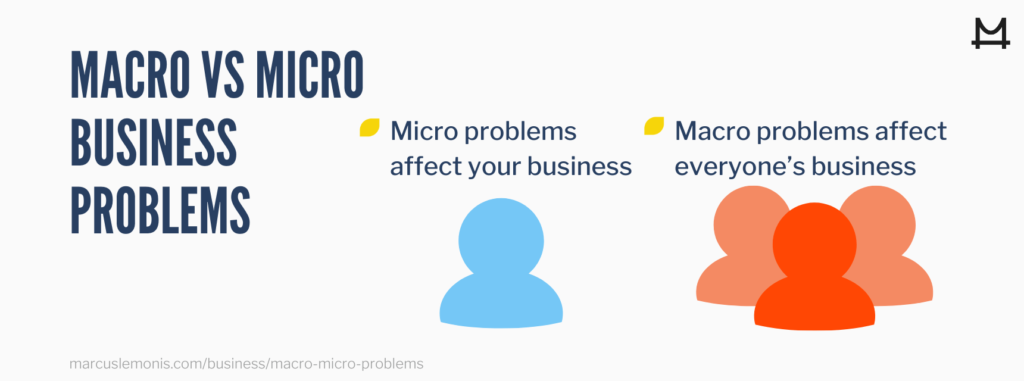
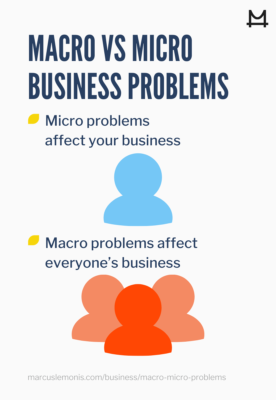
5 Micro Business Problems:
1. Customers
When it comes to macro vs micro, a change in customer is a micro problem because it affects your company specifically. The vinyl record companies gave us a great example of this when their customer base transformed around 2010. Nielsen Soundscan, an aggregator of music data, reported that roughly 1 million vinyl records sold in 2007. But by 2012, that number soared to 4.5 million units. That’s an absolutely huge pop in sales and worth looking into. It turned out the uptick was because young people were buying records again. So, the vinyl companies knew they had a micro problem: their customer had changed, meaning they needed to shift their messaging. Make sure to stay on top of your market research, so you’re able to spot and cater to a change in your customer base.
2. Competitors
Similar to the above, when you have a disruptive competitor, that’s a micro problem because the challenge is yours instead of everyone’s. Do you remember when Gillette came out with the Mach 3 razor and Schick responded with the “Quattro?”

They were locked in a competition for the closest, smoothest shave. But then Dollar Shave Club burst onto the scene and started competing based on convenience. They delivered razors straight to your door, and what’s more, they did it on the subscription model so the re-ordering process was automated. For Gillette, this was a paradigm-shifting micro challenge and one that required a strong response. As Marcus likes to put it, “If you don’t evolve, you die.” Gillette picked the first option, then launched their own delivery service to stay competitive. You can stay on top of similar challenges by keeping tabs on what your competition is doing and making sure to respond.
3. Supplier
Like any relationship, your dynamic with a supplier can hit a rough patch. Has your supplier ever created any quality issues? Have they ever been late on a delivery? Do they get so busy that they can’t fill your order in a timely manner? Did they raise prices and eliminate your margin? Keep an eye on every single aspect of this micro problem and that assessment will illuminate next steps.
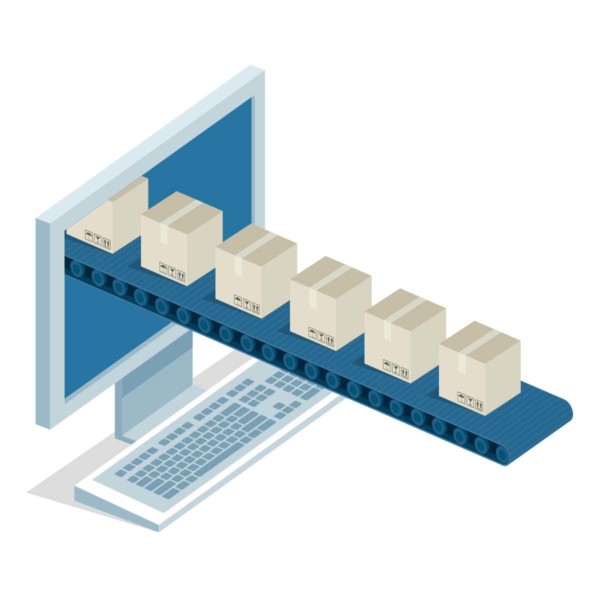
It might be as easy as communicating that you can’t make any money at their current price and renegotiating. But if it’s a quality thing they can’t seem to resolve, it might be time to move on. Also, make sure you’re set up to switch gears if it really is necessary, especially if you’re in a hyper-specific niche. When you’re selling a piece of equipment used in laser eye surgeries, for example, you can’t line up a new supplier overnight. So, it’s good to know who’s out there. Don’t be afraid to shop around. Marcus has a pretty nice way of simplifying these things when he says: “High performance, high reward. Low performance, there’s the door.” Do your suppliers pass Marcus’ test?
4. Resellers
Similar to your suppliers, you also have a symbiotic relationship with your resellers. Do you sell your product through retailers? Are they marketing your product in a way that represents your interests? Are they pricing your product in a way that’s moving units? When a customer interacts with their sales team, how often does that get you a result? You may need to take a hard look at this micro challenge to build a clear understanding of what’s working. But don’t be afraid to look in the mirror.

When Marcus worked with a watch company in California, they set up a display case of watches that would be placed next to the retailer’s cash register. Each of the 10 different watch styles represented a specific charity where a portion of the proceeds would be given with each sale. The watch designs were vibrant and modern but Marcus noticed that the case itself could use an upgrade. It didn’t resemble the colorful look and feel of the watches. So, they reworked the display case in a way that showed off the vibrance of the brand and the results were increased sales and a better outlook for the brand. They learned the importance of always looking for ways to optimize the reseller relationship to keep it firing on all cylinders.
5. Public Perception
When British Petroleum’s rig exploded in 2010, oil poisoned the ocean and BP had a serious micro problem on their hands: public perception. Their reputation had taken a major hit and they needed to make things right with the public. So, they responded in a few ways. They worked on cleaning up the spill, committed $500 million to environmental research, gave billions of dollars in financial assistance to numerous affected businesses, and spent time and money working on PR promising to do better. You’ll likely never have to deal with a catastrophe this large, but it gives you an important reminder to factor in public perception. Is there a way you can make things right and have you communicated that to the public?

Keep in mind, sometimes you’ll have a problem with public perception even when you haven’t done anything wrong. The animal shelters in Los Angeles ran into a situation like this when they realized they were up against a common misunderstanding: rescue pets have behavioral problems. That’s not always true. Plenty of rescue pets make amazing companions. So, the shelters launched a hilarious and successful campaign detailing all the funny ways a rescue pet can surprise you. It’s important that you know how the public perceives your company. If you’re open to constructive feedback, there’s always a way to improve that dialogue.
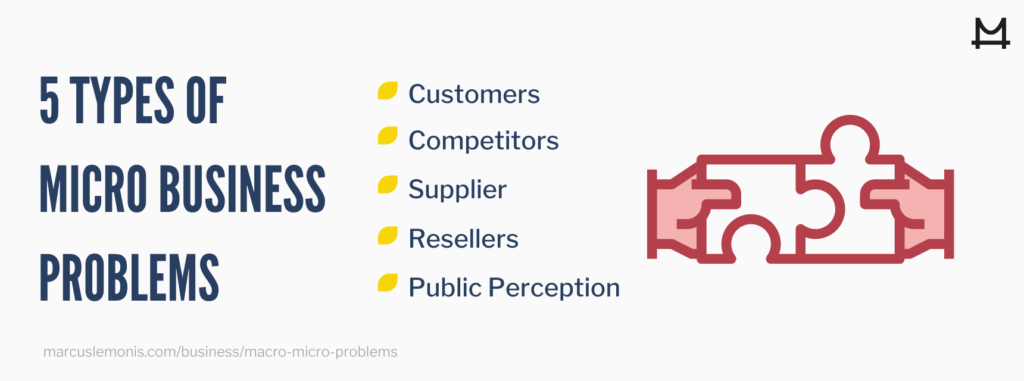
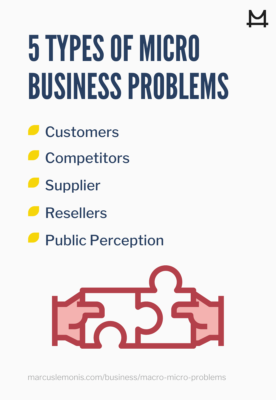
4 Macro Business Problems
Macro problems, as mentioned prior, affect everyone instead of just you. They’re huge, sweeping factors, and simply put, aren’t your fault. To some extent, everyone’s going through it. There are often a few different macro trends in play at the same time, so their impact can be slightly abstract. But you still need to keep an eye on these so you have one more valuable piece of information to factor in. Below are a few big-picture shifts to monitor and a broad look at how they might have an impact on your business.
1. Economic Factors
These include interest rates, exchange rates, a recession, or a change in taxes. A change in interest rates, for example, might mean it’s more expensive for you to borrow money. An increase in taxes might mean your customers have less expendable income and are willing to spend less on each purchase.
2. Demographics
This can refer to age, education, background, or lifestyle. If fewer people are going to college, SAT prep courses take a hit. Whereas a drastic population decline in The Rust Belt might mean it’s a bad year to increase your marketing spend in Akron.

3. Cultural Shifts
This is a nod to the general sensibility of the world. Whether things are moving in a more health-conscious direction, or there’s more pressure for companies to be socially responsible, it’s always an advantage when you know where things are headed. Is there a way you can use a “buy one, donate one” model, demonstrate your company’s eco-friendly initiatives or donate a portion of your proceeds to a worthy cause, for example?
4. Technology
This one speaks for itself, but it’s crucial to keep your finger on the pulse of today’s innovations. Technology is moving at light speed and you don’t want your company to be left behind. If you own a kiosk that makes physical copies of keys, for example, you need to be aware of keyless entry. Likewise, a realtor whose competitor offers VR tours might want to start offering the same. Is technology phasing out part of your business? If so, it may be time to diversify.
Again, the impact of macro problems can be slightly nebulous. But as Marcus would say, “You’ve got this!” You’re more intuitive than you realize. Sometimes a common-sense analysis does the trick. If the macro problem is big enough, like our culture slowly turning against plastic straws, you’ll obviously want to start pricing out some paper options. But if interest rates and the tax code change at the same time, you might not have the answers off the top of your head. That’s okay too, because you know what you don’t know and can either read up or seek out an expert opinion, and prepare. When it comes to macro problems, the devil you know is always better than the devil you don’t.
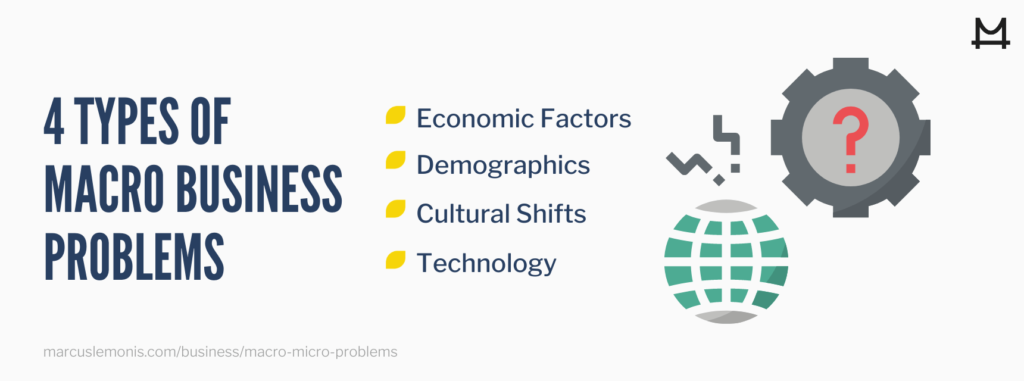
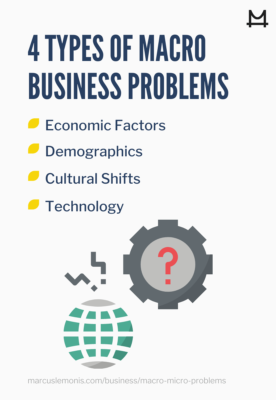
Macro vs Micro – Why It's So Important to Know the Difference
Let’s say your business is making money hand over fist, but out of nowhere, your sales tank for an entire month. The last thing you want to do is start flailing around, reacting in an uninformed way, and changing all the things you were doing right. Remember, everything was going great. Maybe it’s not a “you” thing. So, you take a look at some big-picture factors and realize China started taxing American imports and your price is no longer competitive. Congratulations. You’ve figured out it’s a macro issue, which means you keep doing all the micro stuff that made you a winner, and all you have to do is shift your international focus.
That’s the power of understanding the macro vs micro. It’s a more advanced form of troubleshooting that allows you to keep what’s working and fix what isn’t. Think of it as another place to look for solutions. But most importantly, when your business hits a snag don’t worry too much – just pick up and keep going. In the words of Marcus, “People make mistakes. I know I do. But it’s how you resolve it that matters.” So, be brave about acknowledging business problems, understand the macro vs micro, and you’ll know exactly which areas need a little attention.
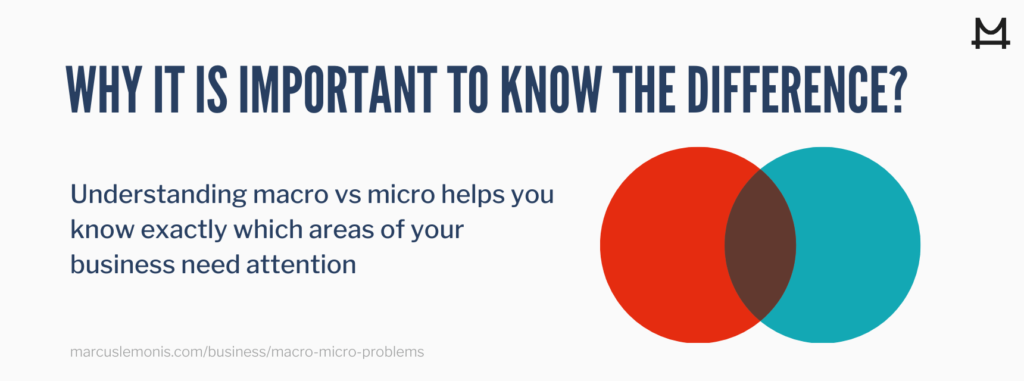

- How does your business currently evaluate macro & micro business problems?
- Are there any areas your business can improve in this area?
Harris, D. (2013, July 19). Hipsters are buying vinyl records, but they aren’t listening to them. Retrieved from https://qz.com/103785/hipsters-are-buying-vinyl-records-but-they-arent-listening-to-them/
Thomas, L. (2017, May 9). Gillette one ups Dollar Shave Club with on-demand razor ordering service where you text to order. Retrieved from https://www.cnbc.com/2017/05/09/gillette-one-ups-dollar-shave-club-with-on-demand-razor-ordering-service-where-you-text-to-order.html
Vidal, J. (2011, April 14). BP’s PR campaign fails to clean up reputation after Gulf oil spill. Retrieved from https://www.theguardian.com/environment/blog/2011/apr/14/bp-pr-campaign-gulf-oil-spill#:~:text=In%20the%20adverts%2C%20BP%20claims,)%20on%20the%20clean%2Dup.





